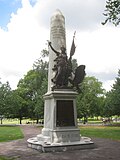Adolph Robert Kraus | |
|---|---|
 | |
| Born | August 5, 1850 Zeulenroda, Germany |
| Died | November 6, 1901 (aged 51) Danvers, Massachusetts, United States |
| Occupation | Sculptor |
Adolph Robert Kraus (August 5, 1850 - November 6, 1901), known professionally as Robert Kraus, was an American sculptor, born in Zeulenroda, Germany, and active in Boston.




